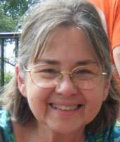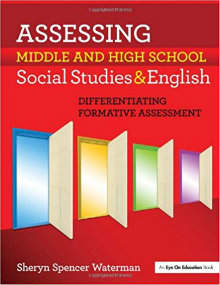ELA & SS: Differentiating Formative Assessment
Assessing Middle and High School Social Studies and English: Differentiating Formative Assessment
By Sheryn Spencer Waterman
(Routledge/Eye On Education, 2010 – Learn more)

Differentiation and assessment are hot topics in schools today. This book shows the way to make the curriculum as well as the evaluation fit the learner.
“Differentiation is the process of tailoring instruction to meet the needs of all the students.” So begins the first chapter entitled “Differentiating Formative Assessment.” The importance of doing this is summed up by a quote from Rick Wormeli (2006): “What is fair isn’t always equal, and our goal as teachers is to be fair and developmentally appropriate, not one size fits all.”

Mastery-Based Strategies
In chapter 2 the author uses mastery-based strategies to devise different assessments. These are then used to regroup students for remediation, enrichment, or re-teaching. Waterman explains her procedures and levels and provides very specific examples of using them.
Her procedure is basically to stop frequently and have the students think-pair-share. She explains how to do this using the Constitution (social studies) and a sample of combining sentences with dependent clauses (language arts). This method facilitates her inclusion of several DFA’s (differentiated formative assessments).
Her examples are built around the assessment target model for direct instruction and assignments. This method motivates students because of the quick feedback and the sequencing of difficulty.
Understanding-Based Differentiated Formative Assessments
The next chapter is one of my favorites. It’s Understanding-Based DFA. Here the focus is on problem-based learning, concept attainment, reading for meaning, and compare and contrast. These strategies use reasoning, analyzing, and providing evidence to show student learning. Examples of these range from comparing and contrasting the Republicans and Democrats; close reading of The History of Computers to get the meaning, and designing a culture booth for a real problem. The term poetry is the example she uses for concept attainment.
Self Expressive-Based DFA
Self Expressive-Based DFA is the topic of chapter 4. The author explains how there are four main types of self expression learning strategies. Inductive learning employs a brainstorming and predicting method to generalize big ideas. Her assessment uses discussion of the characteristics of science fiction. Metaphorical expression arrives at meaning via a creative comparison mode. Students compare the parts of a story to the Progressive Era.
A Pattern Maker pays attention to patterns and extrapolates information. The main example is building a media timeline. This would be applicable to either ELA or Social Studies. Finally we come to Mind’s Eye. This student visualizes and translates words into pictures. The Green Mamba is used as the example of visualizing to form inferences. Students who are creative and use their imaginations would do well with these ideas.
Interpersonal DFA’s
If you have students who like to work together and help each other, you will be inspired by the Interpersonal DFA’s in chapter 5. First there is the Reciprocal Learning example using vocabulary from the Tell Tale Heart. There is even a procedure for a vocabulary team. The Problem Solving Learning example uses a decision-making model using planning a theme-based trip. This idea would work for a novel as well as a country or a topic like justice.
Jigsaw is a cooperative learning strategy where each student in a group learns one section of the divided up material and then teaches their section to others in the group. The Big Six research method is the sample. Lastly, we have the Community Circle. This is a way for students to voice their thoughts as in a classroom meeting. It could be based on an issue they are having or a topic in their studies.
The final chapter gives ideas that tap into all four learning styles. Four main ideas are given: Window Notes, Circle of Knowledge/Seminar, Task Rotation, and Do You Hear What I Hear? Just like the other strategies in the book, these strategies are replete with step-by-step instructions and rubrics.
Because this book is both current in topics and methods, I think that we might all want to make a place for it in our libraries.
Joanne Bell is a middle school teacher at St. Joseph Elementary School in Cottleville, Missouri. She currently teaches social studies to sixth and seventh graders, but has spent most of her 34 years in the elementary grades.

































